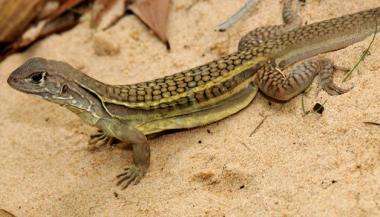November 11, 2010 report
Newly identified self-cloning lizard found in Vietnam

(PhysOrg.com) -- Scientists have just discovered that a small lizard, long known as a restaurant food item in southeastern Vietnam, is an all-female species that reproduces through "cloning" itself.
The lizard, Leiolepis ngovantrii, was found by Ngo Van Tri from the Vietnam Academy of Science and Technology and classified by L. Lee Grismer, a herpetologist from La Sierra University in Riverside, California. The species was previously unknown to science, even though it has been eaten in the Mekong Delta region as long as anyone can remember.
Ngo first found the lizard at a restaurant in Ba Ria-Vung Tau Province, where live specimens were being kept in a tank. Ngo noticed all the individuals looked identical, and sent photographs to his colleague Grismer and his PhD student son Jesse. The Grismers identified the lizard as probably belonging to the Leiolepis genus, but in this genus males and females have different coloration, and the photographs showed only males. This made them suspect the new species consisted only of females.
The Grismers flew to Ho Chi Minh City and telephoned the restaurant to ask them to keep the lizards alive until they could get there eight hours later. By the time they arrived the “crazy guy” restaurant owner had got drunk and sold them all, but the scientists found more specimens at other restaurants, and were aided by local school children to find more in the wild. They found nearly 70 of the lizards altogether, and all were females.
The findings, published in the journal ZOOTAXA, also identified unique rows of enlarged scales on its forelimbs and bone layers (lamellae) under their toes. Grismer said the species, which lives in a transition zone between coastal sand dunes and scrub, may be a hybrid of two related species of maternal and paternal lizards that thrive in the separate habitats.
Genetic testing of mitochondrial DNA has identified the maternal species as L. guttata, but the paternal species is not yet known. (Mitochondrial DNA is passed down only through females.)
The newly described species is not the only one that reproduces through cloning, since around one percent of lizard species reproduce with no contribution from males, by a process known as parthenogenesis (from the Greek for virgin birth). In this process the ovum contains a full complement of chromosomes and develops into an embryo without being fertilized. Parthenogenesis also occurs, but rarely, in fish and invertebrates, especially insects such as aphids, and has been artificially induced in mice and other species.
The Leiolepis ngovantrii species is not rare in the area in which it was found, but some herpetologists such as Charles Cole of the American Museum of Natural History in New York, think as a hybrid species it may be more prone to extinction because of the reduced genetic variation from one generation to the next. Cole said unisexual species do not generally survive as long as other species of lizards, but they can be healthier in the short term.
More information: ZOOTAXA paper (PDF): www.mapress.com/zootaxa/2010/f/z02433p061f.pdf
© 2010 PhysOrg.com















